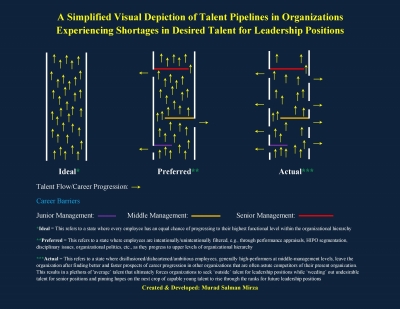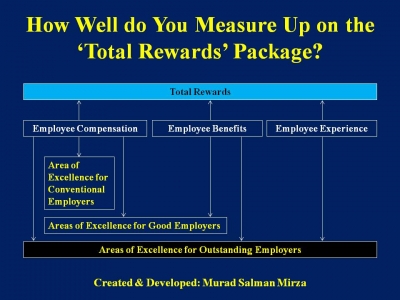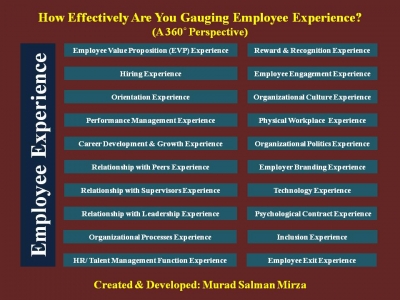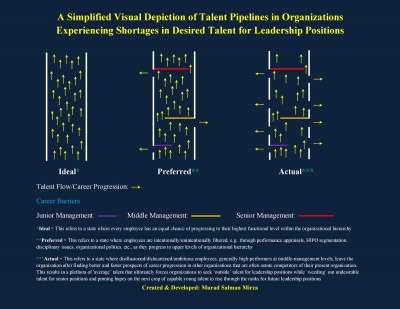The dreaded prospect of becoming irrelevant and marginalized in the Digital Age is increasingly incentivizing organizations to look for ways to attract and retain desired talent who can sustain and enhance their competitiveness with a synergistic infusion of technology. However, gone are the days when professionals depended upon the paternalistic instincts of their employers to provide them with a viable career path embellished by a progressive and fair remuneration. The capable professional of today is more informed, incisively skilled, and comes with a bushel of knowledge that enables leveraged negotiating targeted to achieve maximum gains within a mutually agreed frame of reference.
The era of “employee loyalty” has been over for a while now, but the concept of “employee partnership” that was built on the ashes of organizational allegiance is also under threat. The new arrangement seems to be one of “employee gratification,” where attractive “total rewards” packages are customized to serve as “golden handcuffs” on the desired talent as long as the organization sees a healthy ROI in terms of retaining them as part of its workforce.
The accepted wisdom in professional circles has been to innovate within the realm of compensation and benefits (C&B) under the guise of total rewards. But that is not enough anymore as employees seek experiential gratification peppered with “organizational goodness” for a robust employment relationship. To put it bluntly, if employees are frequently thinking about their “seemingly attractive” remuneration being worth the “crap” they take every day, then the organization has failed handsomely in its total rewards strategy.
Any total rewards package that does not reinforce employee engagement and wellbeing is a recipe for profound talent attrition in the Digital Age. Therefore, organizations that can provide the strongest “jovial anchors” for their employees will be the ones to have a healthy pool of desired talent for effectively overcoming the daunting challenges of the Digital Age. This becomes critically important for harvesting future leaders through robust talent pipelines by avoiding the pitfalls illustrated in the following chart:

Consequently, such a realization has propelled employee experience into the limelight, and exceling in the respective context has become the defining characteristic of outstanding employers as compared to being good employers. This can be visualized as follows:

Here is a brief checklist that can be used as an overall guide for assessing the directional congruency of initiatives in the respective context:
- Do you have a formal employee experience program as part of the total rewards package?
- Do you link the employee experience program with the core values of the organization?
- Do you audit/review the effectiveness of the formal employee experience program at defined intervals for refinement and improvement purposes?
- Do you include employee experience as a critical part of the performance appraisal of the supervisors?
- Do you get regular feedback on the formal employee experience program during employee exit interviews?
- Do you use employee experience as a recruiting tool, especially by leveraging former employees?
- Do you benchmark your employee experience program with prominent organizations in the same and/or other industries?
Detailed analysis can be done by formulating insightful questions under the following headings:

An Employee Equation
Total rewards packages lacking an invigorating employee experience and designed to hover around the industry norm often relegate corporate entities to self-inflicted mediocrity in terms of functional agility, talent relevancy, and organizational competitiveness, while trying to meet the challenges of the Digital Age. Therefore, it is imperative that an organization is able to consistently provide an enriching employee experience that rejuvenates engagement and boosts wellbeing. Let’s explore the following equation in the respective context:
IEE = FP + UE + PS
IEE = Invigorating Employee Experience
FP = Formal Promises (Contractual Obligations)
UE = Unstated Expectations (Psychological Contracts)
PS = Pleasant Surprises (Delight Factors)
Examples of these elements include:
- Formal Promises (Contractual Obligations), e.g., honoring the agreed-to remuneration, adhering to the core values, providing necessary training and development, provision of stated workplace amenities, impartial resolution of conflicts, protection against bullying, etc.
- Unstated Expectations (Psychological Contracts), e.g., will not be mistreated, especially in front of peers, will be given ample chances to prove themselves with high-profile assignments, will be paired with an effective mentor, will not be discriminated against in terms of pay packages, will have adequate access facilities for employees with disabilities, will be taken into confidence regarding technology induction, will be offered reskilling opportunities rather than given the shock of mandatory rightsizing, will not be ostracized for internal whistle-blowing, etc.
- Pleasant Surprises (Delight Factors), e.g., enabling the fulfillment of a “bucket list” item, throwing an unannounced birthday party, arranging baby showers for pregnant employees, providing a complimentary childcare facility near the office for parents of autistic children, creating a “vent room” at the office for managing stress, providing complimentary learning of hobby-based skills (such as knitting, crocheting, a new language, singing, dancing, painting, playing musical instruments, calligraphy, professional writing, horse riding, urban gardening, pet care, etc.), facilitating unexpected reunion of expats with their long-separated family members, publicly celebrating the accomplishment of an employee’s child, giving paid time-off to volunteer for a favorite charity, providing an entrepreneurial chance to start a business that complements the organization (i.e., Amazon is encouraging employees to start their own delivery businesses by giving them money and training), etc.
A World Full of Challenges
The criticality of optimizing the equation is underscored by the fact that today’s multigenerational workforce is looking at existential challenges that are more pronounced and transformative than for earlier professionals. These include:
- Narrowing occupational paths
- Reskilling imperatives
- Multiple careers
- Early retirement
- Forced entrepreneurship
This is especially true as artificial intelligence (AI) progressively conquers the strictly humanistic domains within the workplace and relentlessly pushes the threshold for relevance to the upper echelons of cerebral application. This can be facilitated by a receptive organizational culture buoyed by cohesive core values and complemented by astute talent management strategies that are bolstered by an enlightened leadership. One of the key success factors in the respective context is to give ample time for resolving “sadness at work” issues before embarking upon “happiness at work” initiatives to avoid cynicism and passive resistance by wary employees.
Additionally, the significance of pairing capable mentors with blossoming talent cannot be overstated as it lays the solid groundwork needed for keeping potential successors focused and galvanized toward maximizing their value addition to the organization while carving admirable careers for themselves. However, few organizations invest in formally engaging such relationships and typically are inclined to providing counseling services through the HR function. This results in the profound loss of a golden opportunity to create strong bonds between the various hierarchical levels, which inevitably manifests in a number of undesirable ways, e.g., communication gaps, failure of psychological contracts, high attrition rates, poor employer brand, lower morale, unsatisfactory working conditions, stagnated career progression, underutilization of talent, sapping of employee delight factors, etc.
A total rewards package infused with a wider bandwidth of an invigorating employee experience is a powerful antidote for the stress and anxiety faced by today’s workforce as employees strive to keep up with the demands of the Digital Age. Exceling in the respective context is increasingly becoming a profound competitive strength for progressive organizations as they break away from the complacent flock of good employers and join the exclusive club of outstanding employers. Are you ready and willing to undertake such a migration?
Murad Salman Mirza is an innovative thinker and an astute practitioner of areas within and associated with the fields of organizational development, talent management, and business transformation. He has lived, studied, and served in different regions of the world, including, the U.S., Australia, South Asia, and the Middle East. His LinkedIn profile can be viewed at: https://www.linkedin.com/in/muradsalmanmirza

